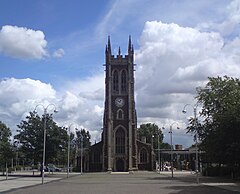Scunthorpe
| Scunthorpe | |
|---|---|
 St John's Church, Scunthorpe |
|
| Scunthorpe shown within Lincolnshire | |
| Population | 65,163 (2011) |
| OS grid reference | SE893102 |
| • London | 145 mi (233 km) S |
| Unitary authority | |
| Ceremonial county | |
| Region | |
| Country | England |
| Sovereign state | United Kingdom |
| Post town | SCUNTHORPE |
| Postcode district | DN15 – 17 |
| Dialling code | 01724 |
| Police | Humberside |
| Fire | Humberside |
| Ambulance | East Midlands |
| EU Parliament | Yorkshire and the Humber |
| UK Parliament | |
Scunthorpe is a town in Lincolnshire, England. It is the administrative centre of the North Lincolnshire unitary authority, and had an estimated total resident population of 65,163 according to the 2011 census. A predominantly industrial town, Scunthorpe, the United Kingdom's largest steel processing centre, is also known as the "Industrial Garden Town". It is the third largest settlement in Lincolnshire, after Lincoln and Grimsby. The Member of Parliament for Scunthorpe is Nic Dakin (Labour).
Scunthorpe as a town came into existence due to the exploitation of the local ironstone resources, and subsequent formation of iron works from the 1850s onwards. The regional population grew from 1,245 in 1851 to 11,167 in 1901 and 45,840 in 1941. During the expansion Scunthorpe expanded to include the former villages of Scunthorpe, Frodingham, Crosby, Brumby and Ashby. Scunthorpe became an urban district in 1891, merged as 'Scunthorpe, Brumby and Frodingham Urban District' in 1919, and became a municipal borough in 1936.
The town appears in the Domesday Book (1086) as Escumesthorpe, which is Old Norse for "Skuma's homestead", a site which is believed to be in the town centre close to where the present-day Market Hill is located.
Scunthorpe is located close to an outcrop of high-lime-content ironstone (~25% iron average) from a seam of the Lias Group strata which dates from the Early Jurassic period and runs north-south through Lincolshire. Ironstone was mined by open cast methods from the 1850s onwards, and by underground mining from the late 1930s. In the 1970s the steel industry in Scunthorpe transitioned to use of ores imported from outside the UK with higher iron content. Underground mining in the area ceased in 1981.
Scunthorpe was close to the epicentre (this was centred at Middle Rasen) of one of the largest earthquakes experienced in the British Isles on 27 February 2008, with a magnitude of 5.2. Significant shocks were felt in Scunthorpe and the surrounding North Lincolnshire area. The main 10-second quake, which struck at 00:56 GMT at a depth of 9.6 mi (15.4 km), was the second largest recorded in the British Isles. In 1984 a quake with a magnitude of 5.4 struck north Wales.
...
Wikipedia

